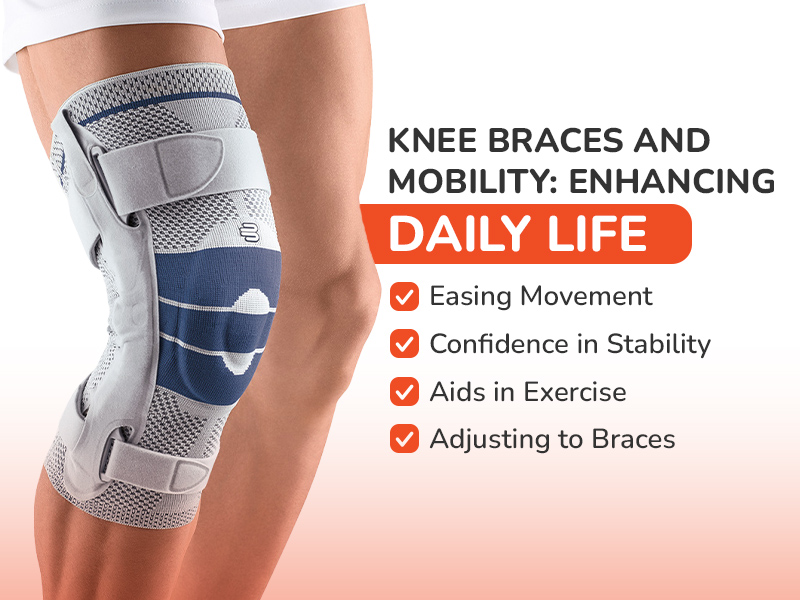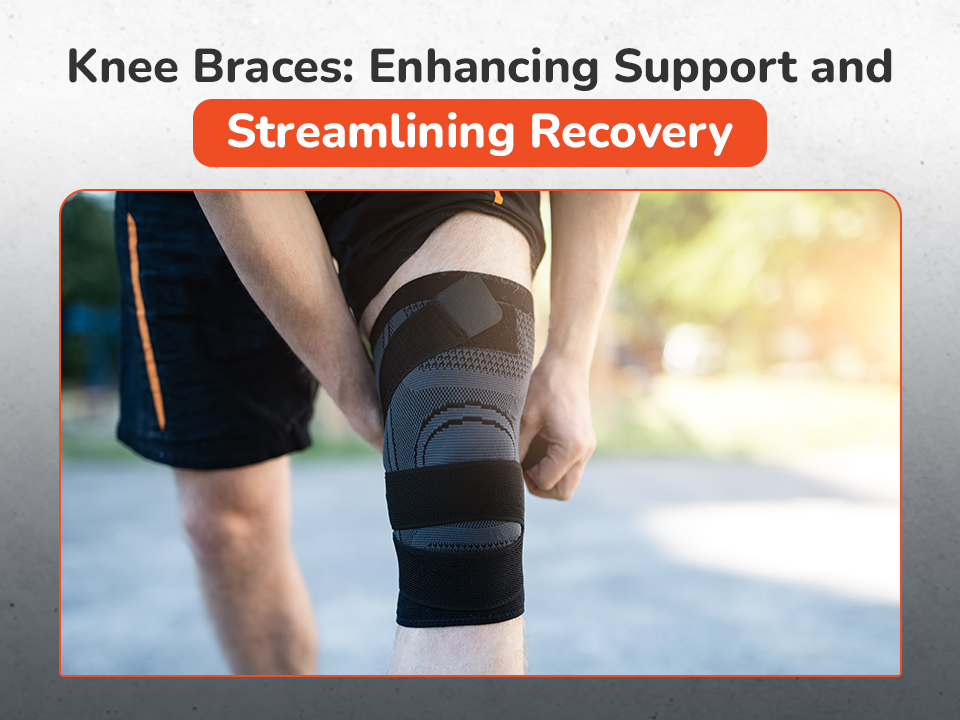Knee Braces: Enhancing Support and Streamlining Recovery
Knee braces are more than just medical devices; they’re lifelines for those grappling with knee pain, injuries, or post-surgery recovery. They come in different shapes and sizes, each with a specific purpose – from providing stability to managing pain and aiding healing. This guide will walk you through everything you need about knee braces, ensuring you make informed decisions for your knee health.
What Are Knee Braces?
Knee braces are specialized supports worn around the knee to provide stability, alleviate pain, and aid in the recovery from injury. They are designed to protect the knee from future injury or risk of damage. This protection is essential for individuals who participate in high-impact sports or activities but is also beneficial for those with knee problems related to age, arthritis, or previous injuries.
These devices work by shifting the weight away from the damaged knee area, providing compression, improving blood flow, and reducing pain. They also enhance proprioception – the body’s ability to sense its position in space – thus improving balance and joint stability.
Different knee braces cater to various needs, from simple sleeves that provide warmth and compression to hinged braces that restrict and control movement to protect the knee during healing. Selecting the right knee brace is crucial and often depends on the type and severity of an injury, advice from a healthcare professional, and personal comfort.
The Benefits of Wearing Knee Braces
Knee braces offer several benefits for individuals with knee problems or those recovering from knee injuries. Here’s how they can help:

- Support and Stabilization: Knee braces are engineered to support the knee joint, which helps stabilize the area during movement and rest. This added support is crucial for weak or injured knees that may require additional assistance to function correctly or to prevent unwanted movements that could lead to further injury.
- Pain Relief: By compressing the knee area, braces can help alleviate pain. They do this by reducing swelling and offering warmth, increasing blood flow to the region. Improved circulation can speed up healing and reduce pain, making everyday activities more comfortable.
- Enhanced Healing: Wearing a knee brace can aid the body’s natural healing process. The additional support ensures that the knee is kept in a proper alignment, which is essential for healing ligaments and tendons. Furthermore, by limiting certain movements, the brace allows the knee to rest appropriately, preventing aggravation of the injury.
- Prevention of Future Injuries: Knee braces are not only for those who have sustained a knee injury or are recovering from surgery. They’re also used preventively, especially by athletes or individuals engaging in high-stress activities. Braces can absorb some of the impacts that the knee might otherwise endure, which is especially beneficial for those who have previously suffered knee injuries and are at a higher risk for future issues.
Types of Knee Braces
Knee braces come in various designs, each serving a specific purpose. Each type of knee brace serves an essential function, from prevention to support and recovery. When selecting a knee brace, it’s crucial to consider the nature of your knee issue and the level of activity you anticipate. Here’s a quick guide to understanding the different types of knee braces available:
- Prophylactic Braces: These protect knees from injuries during high-contact sports like football. They’re sturdy and shield against impacts that could otherwise harm the knee.
- Functional Braces: After you’ve suffered from a knee injury, functional braces step in to aid in stability and support during the healing process. They help the knee to move correctly while still providing a safeguard against further damage.
- Rehabilitative Braces: Post-surgery or after a significant injury, rehabilitative braces limit harmful knee movement while allowing for some controlled range of motion essential for recovery. They’re often used in the early stages of rehabilitation.
- Unloader/Offloader Braces: These are specialized braces designed to relieve people suffering from arthritis. They work by ‘unloading’ or shifting pressure from the damaged knee to a stronger area, reducing pain and discomfort.
Selecting the Right Knee Brace
Selecting the right knee brace is crucial for effective support and recovery. Here’s a brief guide to help you make an informed decision:
- Understanding Different Knee Conditions: Different knee conditions require different types of braces. For instance, a mild knee strain may only need a basic sleeve for compression and warmth, while a post-operative knee might require a more robust hinged brace.
- Consulting with Healthcare Providers: Always seek advice from healthcare professionals such as orthopedists or physiotherapists. They can diagnose your condition accurately and recommend a brace that suits your needs.
- Importance of the Right Fit: A knee brace should fit snugly around your knee without causing discomfort or restricting circulation. A brace that is too tight can be counterproductive, causing pain or swelling, while a loose brace might not provide the necessary support.
How to Properly Use a Knee Brace?
Using a knee brace correctly can significantly improve its effectiveness. Here’s how to ensure you’re getting the most out of your knee brace:
- Steps for Wearing a Knee Brace: Begin by reading the instructions for the brace. Slide or wrap the brace around your knee as directed, ensuring it sits comfortably above and below the kneecap. If there are straps, fasten them so that they provide even compression without digging into your skin.
- Do’s and Don’ts: Wear your knee brace during activities that might put extra strain on your knee. Don’t wear it so tight that it cuts off circulation or causes numbness. Ensure your brace is clean and dry when you put it on. Don’t use a brace that shows signs of wear or doesn’t provide the right level of support anymore.
- Combining Brace Use with Other Treatments: A knee brace should be part of a comprehensive treatment plan. This may include physical therapy exercises, rest, ice, compression, elevation (RICE), and possibly medication for pain relief. Always follow your healthcare provider’s advice on how to combine these treatments with the use of your knee brace.
Read More: How Knee Braces Help Seniors Avoid Injury and Perform Better?
Maintenance and Care for Knee Braces
Ensuring your knee brace is well-maintained is just as important as using it correctly. Here are some tips for the care and maintenance of your knee brace:
- Cleaning: Always adhere to the manufacturer’s instructions when cleaning your knee brace. Most soft braces can be hand-washed with mild soap and lukewarm water. Avoid harsh chemicals or hot water that could degrade the materials. For braces with metal components, wipe them down with a damp cloth and dry them immediately to prevent rusting.
- Storage: When not used, store your knee brace in a cool, dry place from direct sunlight, which can wear down the materials over time. Keep the brace laid out flat or in its natural shape to avoid creases or the breakdown of support structures within the brace.
- Inspection: Regularly inspect your brace for signs of wear and tear. Look for stretching, fraying straps, cracks in the support structures, or any other damage that might affect the brace’s function.
- When to Replace: If you notice significant damage or the brace no longer fits properly due to stretching or body changes, it’s time to replace it. A brace that doesn’t provide the right support can do more harm than good. Additionally, if your brace becomes uncomfortable to wear or causes skin irritation despite proper cleaning, consider a replacement.
Knee Braces and Mobility: Enhancing Daily Life
Knee braces are more than just recovery aids; they can significantly enhance mobility and independence for those dealing with knee issues. Here’s how they assist in everyday activities and some insights into the experiences of users:

- Easing Movement: Knee braces support the knee during movement, making it easier to perform daily activities such as walking, climbing stairs, or standing for long periods. They can alleviate the pressure on the knee joint, making these activities less painful.
- Confidence in Stability: Knee braces provide the stability that helps reduce the fear of re-injury. This psychological benefit is significant as it encourages users to be more active and confident in their movements, contributing to a healthier lifestyle.
- Aids in Exercise: Braces can facilitate light exercise routines for those looking to maintain fitness while managing a knee condition. They offer the necessary support, allowing low-impact workouts that keep the muscles strong without overburdening the knee.
- Adjusting to Braces: While getting used to wearing a knee brace may take some time, users often find that the benefits outweigh any initial discomfort. With the right fit and type, a knee brace becomes a valuable ally in maintaining an active, fulfilling life despite knee issues.
Conclusion
In conclusion, knee braces serve as a valuable aid for individuals experiencing knee issues, offering support, pain management, and protection against further injury. Disposing common myths and approaching their use with accurate information and realistic expectations is crucial. Remember, a knee brace is most effective when it’s the correct type for your condition, properly fitted, and used as part of a broader treatment strategy that may include physical therapy, medication, and lifestyle adjustments.



